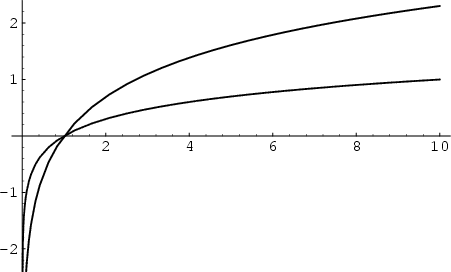|
|
|

The logarithm is defined to be the Inverse Function of taking a number to a given Power. Therefore, for any ![]() and
and ![]() ,
,
| (1) |
| (2) |
Logarithms are used in many areas of science and engineering in which quantities vary over a large range. For example, the decibel scale for the loudness of sound, the Richter scale of earthquake magnitudes, and the astronomical scale of stellar brightnesses are all logarithmic scales.

The logarithm can also be defined for Complex arguments, as shown above. If the logarithm is taken as the forward function, the function taking the Base to a given Power is then called the Antilogarithm.
For ![]() ,
,
![]() is called the Characteristic and
is called the Characteristic and
![]() is called the
Mantissa. Division and multiplication identities follow from these
is called the
Mantissa. Division and multiplication identities follow from these
| (3) |
| (4) |
| (5) |
| (6) |
| (7) |
| (8) |
| (9) |
| (10) |
| (11) |
The logarithm Base e is called the Natural Logarithm and is denoted ![]() (Ln). The logarithm Base 10 is denoted
(Ln). The logarithm Base 10 is denoted ![]() (Log), (although mathematics texts
often use
(Log), (although mathematics texts
often use ![]() to mean
to mean ![]() ). The logarithm Base 2 is denoted
). The logarithm Base 2 is denoted ![]() (Lg).
(Lg).
An interesting property of logarithms follows from looking for a number ![]() such that
such that
| (12) |
| (13) |
| (14) |
| (15) |
| (16) |
Numbers of the form ![]() are Irrational if
are Irrational if ![]() and
and ![]() are Integers, one of which has
a Prime factor which the other lacks. A. Baker made a major step forward in Transcendental Number theory by
proving the transcendence of sums of numbers of the form
are Integers, one of which has
a Prime factor which the other lacks. A. Baker made a major step forward in Transcendental Number theory by
proving the transcendence of sums of numbers of the form
![]() for
for ![]() and
and ![]() Algebraic
Numbers.
Algebraic
Numbers.
See also Antilogarithm, Cologarithm, e, Exponential Function, Harmonic Logarithm, Lg, Ln, Log, Logarithmic Number, Napierian Logarithm, Natural Logarithm, Power
References
Abramowitz, M. and Stegun, C. A. (Eds.). ``Logarithmic Function.'' §4.1 in
Handbook of Mathematical Functions with Formulas, Graphs, and Mathematical Tables, 9th printing.
New York: Dover, pp. 67-69, 1972.
Conway, J. H. and Guy, R. K. ``Logarithms.'' The Book of Numbers. New York: Springer-Verlag, pp. 248-252, 1996.
Beyer, W. H. ``Logarithms.'' CRC Standard Mathematical Tables, 28th ed. Boca Raton, FL: CRC Press, pp. 159-160, 1987.
Pappas, T. ``Earthquakes and Logarithms.'' The Joy of Mathematics. San Carlos, CA: Wide World Publ./Tetra,
pp. 20-21, 1989.
Spanier, J. and Oldham, K. B. ``The Logarithmic Function
![]() .''
Ch. 25 in An Atlas of Functions. Washington, DC: Hemisphere, pp. 225-232, 1987.
.''
Ch. 25 in An Atlas of Functions. Washington, DC: Hemisphere, pp. 225-232, 1987.
|
|
|
© 1996-9 Eric W. Weisstein